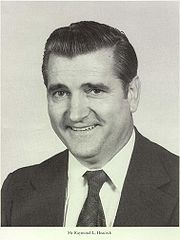
Raymond Heacock
Encyclopedia

James Watt International Medal
The James Watt Medal is the name of two awards named after Scottish engineer James Watt, both awarded for excellence in engineering:-James Watt International Gold Medal of the Institution of Mechanical Engineers:...
for 1979, was a Caltech engineering graduate who spent his career at NASA
NASA
The National Aeronautics and Space Administration is the agency of the United States government that is responsible for the nation's civilian space program and for aeronautics and aerospace research...
's Jet Propulsion Laboratory
Jet Propulsion Laboratory
Jet Propulsion Laboratory is a federally funded research and development center and NASA field center located in the San Gabriel Valley area of Los Angeles County, California, United States. The facility is headquartered in the city of Pasadena on the border of La Cañada Flintridge and Pasadena...
where he worked on the Ranger program
Ranger program
The Ranger program was a series of unmanned space missions by the United States in the 1960s whose objective was to obtain the first close-up images of the surface of the Moon. The Ranger spacecraft were designed to take images of the lunar surface, returning those images until they were destroyed...
in the 1960s and on the Voyager program
Voyager program
The Voyager program is a U.S program that launched two unmanned space missions, scientific probes Voyager 1 and Voyager 2. They were launched in 1977 to take advantage of a favorable planetary alignment of the late 1970s...
in the 1970s and 80s.
Education and work
Mr Heacock joined the Jet Propulsion Laboratory in 1953 after receiving his Master of Science Degree in Engineering from the California Institute of Technology. Prior to joining the Voyager Project in 1972 as Spacecraft Systems Manager he had advanced through various positions of responsibility at the Laboratory. In October 1977 he was appointed Deputy Manager of the Voyager Project and became Manager last year. He is a member of the American Institute of Aeronautics and Astronautics and has served as Secretary, Treasurer, Vice-President and President of the Board of Directors of the Caltech Alumni Association. Mr Heacock is a native of Santa Ana, California and now lives in La Crescenta. We are delighted to welcome him here today and to welcome also Mrs Heacock and their three children.Since the inception of the Voyager Project in 1972, Mr Heacock has been deeply involved in guiding and shaping the successful development and operation of the sophisticated craft. The scientific data from the flight experiments carried aboard them have yielded startling new information on Jupiter and promise to reveal a wealth of knowledge about Saturn and Uranus. Mr Heacock has been a leader in the design, development and flight operations of these craft as well as of their scientific instruments complement. As Spacecraft System Manager, Deputy Project Manager and, currently, Project Manager he has contributed personally to the development of various advanced design features leading to the Project's outstanding success.
NASA's two robot spacecraft, Voyager 1 and 2, were launched in the Summer of 1977 on their journeys to Jupiter of more than 625 million miles. A fitting tribute to the efforts and ingenuity of many engineers and scientists, the spacecraft have now completed successfully the first stage of the exploration of the outer solar system. Voyager 1 is due to reach Saturn in November and will then leave the solar system. Voyager 2 will reach Saturn in August 1981 and may then go on to Uranus and Neptune. The complexity of the problems which have had to be overcome must have been immense and the brilliant team of scientists and engineers of which Mr Heacock has been a predominant leader have reached an unsurpassed level of scientific and engineering achievement. It is therefore most appropriate that the James Watt International Medal should be awarded to Mr Raymond L. Heacock.
James Watt International Medal
The presentation of the 1979 James Watt International Medal was made on Wednesday, 25 June 1980 at the Institute of Mechanical Engineers in London. The Medal was presented to Mr Raymond L. Heacock, Project Manager—Voyager, Jet Propulsion Laboratory, California Institute of Technology in Pasadena, California, by the President of the Institution of Mechanical Engineers, Mr Bryan Hildrew, C.B.E., M.Sc, D.I.C., F.Eng., F.I.Mech.E., F.I.Mar.E., who read a citation.The James Watt International Medal is awarded biennially to an engineer of any nationality who is deemed worthy of this, the highest award which the Institution of Mechanical Engineers can bestow. The Council has awarded the 1979 Medal to Mr Raymond L. Heacock for his outstanding achievements as leader of the team responsible for shaping the development and execution of the technically advanced spacecraft used by the United States of America in the exploration of the outer planets of our solar system.

